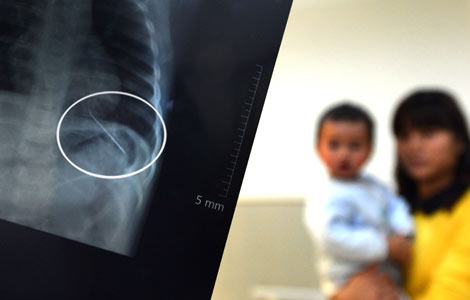
|
China's local government debt and contingent liabilities stood at 17.89 trillion yuan ($2.93 trillion) at the end of last June, the National Audit Office says. Provided to China Daily |
Figure represents 67 percent rise from previous audit results at the end of 2010
The result of the most thorough audit of the nation's local government debt at the end of last year offered a sense of relief as well as worry to global investors.
The sense of relief came as a result of the eagerly awaited figure for the country's debt. Local government debt and contingent liabilities ballooned to 17.89 trillion yuan ($2.93 trillion) by the end of last June, a level widely regarded as acceptable by investors.
The figure, published on the National Audit Office's official website on Dec 30, represented a 67 percent rise from a previous estimate of 10.7 trillion yuan at the end of 2010.
Beijing embarked on the audit in July, prompted by growing concerns over the amount of debt and its potential impact on the world's second-largest economy.
The official process, involving 54,400 auditors across the country, examined liabilities at five levels of government: central, provincial, prefectural, county and township. The 2010 audit covered only provincial, prefectural and county government debt.
The audit showed that local governments' direct debt - debt that will be repaid by government fiscal revenue - totaled 10.88 trillion yuan.
Contingent debt, which is defined as debt that is supposed to be repaid by the return on projects, reached 7 trillion yuan.
The contingent debt tally includes debt for which local governments issued official guarantees (2.67 trillion yuan) and debt with implicit government guarantees (4.34 trillion yuan).
Combined with another 9.81 trillion yuan in direct central government debt, 0.23 trillion yuan in central government backed debt and 2.3 trillion yuan in debt with implicit central government guarantee, China's total government debt as of June was 30.27 trillion yuan.
"We believe the markets and the Chinese government should be alarmed by the rapidly rising leverage, but we do not believe China is on the brink of a debt crisis, especially if the new leaders can take decisive measures to arrest its rising leverage," Lu Ting, an economist at Bank of America Merrill Lynch in Hong Kong, said in a research report.
Lu cited the central government's "very low" ratio of debt to GDP, which stands at 21 percent.

As almost all government debt is denominated in China's own currency and held domestically, "the People's Bank of China can prevent a public debt crisis with its unlimited capability for liquidity supply", Lu said.
China is protected by national savings that include $3.5 trillion in foreign exchange reserves, Lu said. Further, its central and local governments have solid assets, and the country still enjoys high economic and fiscal revenue growth.
The National Audit Office said the debt-to-GDP ratio at the end of 2012 was 39.43 percent, well within the 60 percent international warning level.
Total debt by the end of 2012 was 113.41 percent of government fiscal revenue; a 90 to 150 percent ratio is considered safe internationally.
"China's government debt risks are under control in general, but there are potential risks in some places," the office said.
Song Li, a local government researcher with the Academy of Macroeconomic Research under the National Development and Reform Commission, says the debt growth is in line with the development of the country's infrastructure and other construction.
"China's urbanization requires huge amounts of financing in infrastructure and other areas. So it is natural to see the rapid rise of debt. Unlike debts in Western countries, which are consumption-oriented, most of China's debts were transformed into property and could yield stable returns," he says.
The National Audit Office's report showed that of all the local government debts, the largest portion, or 32.4 percent, was invested in municipal construction. The second-largest portion 22.9 percent was invested in transport.
"The National Audit Office's audit improves transparency, which has been a key weakness for the Chinese local and regional government sector. Routine provision of data on aggregate local and regional government debt and other key metrics would be a major step toward addressing this weakness," said a statement from Fitch Ratings, a global ratings agency on Jan 3.
Fitch downgraded China's sovereign long-term local-currency rating to A+ from AA-, and its outlook from "stable" to "negative" last April, citing a number of "underlying structural weaknesses" in the Chinese economy, including a rapid expansion of credit.
However, pessimists could find ample sources for worry from the National Audit Office results.
"The problem with China's local government debt is not its absolute size, but its rapid expansion," says Guan Qingyou, assistant dean of Minsheng Securities Research.
Based on the results, he estimated that China's local government debt expanded at an annual rate of 21.9 percent in the period of 2010-12, 8.3 percentage points higher than the nominal GDP expansion rate during the same period.
The result revealed that two provinces, 31 prefectures and 29 counties had repaid more than 20 percent of their debts by raising new debt in 2012.
A day after the National Audit Office's revelation, the National Development and Reform Commission, China's top economic planner, said it will allow bond swaps in an effort to avoid defaults in local government-created separate investment agencies. Experts said this offered fresh evidence that a growing number of local government financing vehicles have repayment difficulties and have to rely on rollovers.
Local governments will face a tough time in 2014, as most of their debts are due for repayment this year. According to the results of the National Audit Office, 2.49 trillion yuan of outstanding government direct debt, or 22.92 percent, was due in the second half of 2013. Another 2.38 trillion yuan of debt, or 21.89 percent, is due this year.
Also, 37.23 percent of debt repayment involved land sale revenue, a level that was deemed too high. The higher the ratio, the higher the risks due to China's property market volatility.
The National Audit Office's results also revealed that China's prefectural level governments had raised the largest debts, or 27 percent of the local debt. County-level governments accounted for the second-largest amount, or 22.1 percent.
"Annual debt growth rates remain higher among lower-tier local and regional governments, which have fewer financial resources and more spending responsibilities under the current institutional framework in China. This makes them more likely to fill the funding gap by debt financing," said ratings agency Fitch.
A big share of the debt stems from spending on new airports, stadiums and other public works as part of the stimulus package that helped China rebound quickly from the 2008 financial crisis.
While Western governments borrowed directly to pay for their stimulus programs, China's debt was concealed temporarily on the books of state banks.
Though the Chinese government stressed that unlike debt in the West, most of the country's debts were transformed into property and could yield stable returns, local governments did borrow to pay for schools and other social programs that are mandated - but not paid for - by the central government.
Auditors also found about 13.5 billion yuan that had been improperly invested in shares and real estate or spent on unauthorized construction, the report said. It said 69 people were implicated but gave no other details.
To effectively curb risks in the future, many experts have suggested China should boost its municipal bond market to give local governments greater scope for financing, a method regarded more transparent and better regulated.
At present, only 10.3 percent of local government debt involves bond issues, the National Audit Office said.
Qi Bin, director of the research center under the China Securities Regulatory Commission, says municipal bonds and asset securitization will be the two major standard methods for future borrowing.
"The audit highlights the importance of local and regional government reforms announced in November," ratings agency Fitch said in the report.
"These include a proposed change in how public officials' performance is evaluated, and a more transparent and efficiently regulated financing system. Effective implementation of these reforms could improve fiscal transparency and overall budget management, which would be credit positive for Chinese local and regional governments."
zhengyangpeng@chinadaily.com.cn
|
A large portion of the local debt stems from spending on public works, such as new airports, stadiums, highways and overpasses. Provided to China Daily |
(China Daily Africa Weekly 01/10/2014 page20)








